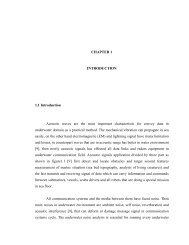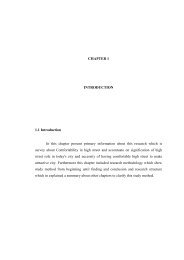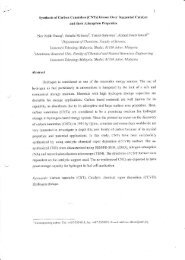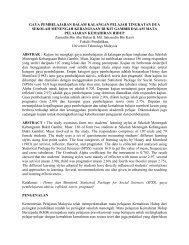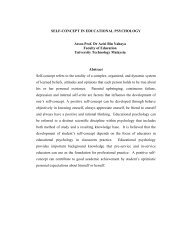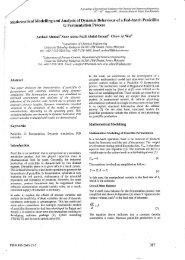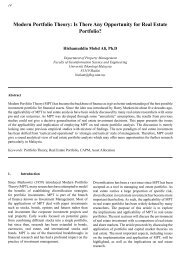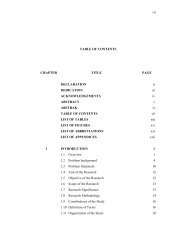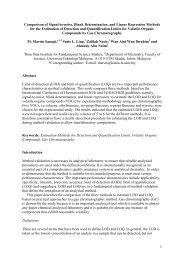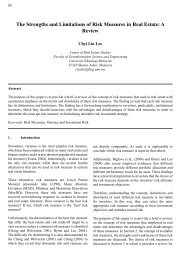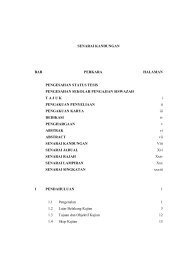Rational approach to the selection of conditions for diastereomeric ...
Rational approach to the selection of conditions for diastereomeric ...
Rational approach to the selection of conditions for diastereomeric ...
Create successful ePaper yourself
Turn your PDF publications into a flip-book with our unique Google optimized e-Paper software.
F. C. Ferreira et al. / Tetrahedron: Asymmetry 17 (2006) 1337–1348 1347<br />
(50 · 2.0 mm, 3 lm) column. Two independent solutions<br />
were employed as mobile phases, water and ACN, both<br />
containing 0.1% <strong>of</strong> TFA, at a flowrate <strong>of</strong> 0.50 ml min 1 .<br />
For <strong>the</strong>se analyses, a solvent gradient from water <strong>to</strong><br />
ACN solution in 20 min was employed, followed by a<br />
plateau <strong>of</strong> 5 min <strong>for</strong> <strong>the</strong> ACN solution. The UV detec<strong>to</strong>r<br />
wavelength was adjusted <strong>to</strong> 259 nm. For analysis, an<br />
aliquot <strong>of</strong> mo<strong>the</strong>r liquor or solid was dissolved in HCl<br />
(5 M) and extracted in<strong>to</strong> mobile phase or DCM. Calibrations<br />
were prepared accordingly.<br />
5.4. Measurement <strong>of</strong> solubility and pKa <strong>for</strong> amines<br />
Pure <strong>diastereomeric</strong> salts <strong>of</strong> <strong>the</strong> amines were prepared by<br />
dissolving pure enantiomers <strong>of</strong> <strong>the</strong> amine and DTTA in<br />
<strong>the</strong> resolution solvent at C <strong>of</strong> 0.2 or 2.0 <strong>for</strong> <strong>the</strong> neutral and<br />
acidic salts, respectively. The isolated solids <strong>of</strong> <strong>the</strong> pure <strong>diastereomeric</strong><br />
salts were added in excess <strong>to</strong> <strong>the</strong> resolution solvent<br />
at <strong>the</strong> final resolution temperature (5 or 25 °C <strong>for</strong> PPI2<br />
or PEA resolutions, respectively), ensuring that a saturated<br />
solution is obtained by observing solid precipitate. The solutions<br />
were left stirring over 24 h and centrifuged <strong>the</strong>reafter.<br />
A known amount <strong>of</strong> <strong>the</strong> resulting liquid phase was dried at<br />
room temperature over 24 h and <strong>the</strong> net mass measured as<br />
<strong>the</strong> dissolved salt in <strong>the</strong> respective sample. The solubility<br />
limit was calculated from <strong>the</strong> mass ratio <strong>of</strong> dissolved crystals,<br />
<strong>the</strong> liquid phase left <strong>to</strong> dry, <strong>the</strong> solvent density, diastereomer<br />
s<strong>to</strong>ichiometry and molecular weight <strong>of</strong> amine<br />
and DTTA. The acid dissociation constants Ka 1 ,Ka 2 and<br />
Ka PPI2 and Ka PEA were measured in <strong>the</strong> resolution solvents<br />
by titration with triethylamine or trifluroacetic acid <strong>for</strong> <strong>the</strong><br />
diacid resolving agent, DTTA, or <strong>the</strong> amines, respectively.<br />
6. Nomenclature<br />
A chiral diacid resolving agent (M)<br />
A 2 di anion chiral diacid resolving agent (M)<br />
AR pure acidic (R)-<strong>diastereomeric</strong> salt (M)<br />
AR2 pure neutral (R)-<strong>diastereomeric</strong> salt (M)<br />
ARS mixed enantiomer neutral diastereomer<br />
salt (M)<br />
AS pure acidic (S)-<strong>diastereomeric</strong> salt (M)<br />
AS2 pure neutral (S)-<strong>diastereomeric</strong> salt (M)<br />
C amine concentration (M)<br />
Cp amine concentration in <strong>the</strong> permeate (M)<br />
Cr amine concentration in <strong>the</strong> retentate (M)<br />
(+)-DTTA (+)-di-O,O 0 -p-<strong>to</strong>luyl-D-tartaric acid<br />
( )-DTTA ( )-di-O,O 0 -p-<strong>to</strong>luyl-L-tartaric acid<br />
ee (solid) enantiomeric excess (%)<br />
ee ML mo<strong>the</strong>r liquor enantiomeric excess (%)<br />
f<br />
Kd 1S =Kd 1 0 S ¼ Kd 1R =Kd 1 0 R<br />
H + hydrogenium cation (M)<br />
H 2 A neutral chiral diacid resolving agent (M)<br />
HA mono-anion chiral diacid resolving agent<br />
(M)<br />
Ka 1 first disassociation acid constant <strong>of</strong> <strong>the</strong><br />
chiral diacid resolving agent (M)<br />
Ka 2 second disassociation acid constant <strong>of</strong> <strong>the</strong><br />
chiral diacid resolving agent (M)<br />
Ka amine disassociation acid constant <strong>of</strong> <strong>the</strong> amine<br />
(M)<br />
Kd 1 <strong>for</strong>mation constant <strong>for</strong> acidic<br />
<strong>diastereomeric</strong> salt (M 1 )<br />
Kd 1S <strong>for</strong>mation constant <strong>for</strong> <strong>the</strong> (S)-acidic<br />
<strong>diastereomeric</strong> salt (M 1 )<br />
Kd 1R <strong>for</strong>mation constant <strong>for</strong> <strong>the</strong> (R)-acidic<br />
<strong>diastereomeric</strong> salt (M 1 )<br />
Kd 1<br />
0 <strong>for</strong>mation constant <strong>for</strong> <strong>the</strong> neutral salt<br />
from <strong>the</strong> acidic salt (M 1 )<br />
Kd 1 0 S <strong>for</strong>mation constant <strong>for</strong> <strong>the</strong> (S)-neutral salt<br />
from <strong>the</strong> (S)-acidic salt (M 1 )<br />
Kd 1 0 R <strong>for</strong>mation constant <strong>for</strong> <strong>the</strong> (R)-neutral<br />
salt from <strong>the</strong> (R)-acidic salt (M 1 )<br />
Kd 2 overall <strong>for</strong>mation constant <strong>for</strong> neutral<br />
<strong>diastereomeric</strong> salt (M 2 )<br />
Kd 2S overall <strong>for</strong>mation constant <strong>for</strong> <strong>the</strong> (S)-<br />
acidic <strong>diastereomeric</strong> salt (M 2 )<br />
Kd 2R overall <strong>for</strong>mation constant <strong>for</strong> <strong>the</strong> (R)-<br />
acidic <strong>diastereomeric</strong> salt (M 2 )<br />
Ks AR solubility limit <strong>of</strong> (R)-acidic salt in <strong>the</strong><br />
resolution solvent (M)<br />
Ks AS solubility limit <strong>of</strong> (S)-acidic salt in <strong>the</strong><br />
resolution solvent (M)<br />
Ks AR2 solubility limit <strong>of</strong> (R)-neutral salt in <strong>the</strong><br />
resolution solvent (M)<br />
Ks AS2 solubility limit <strong>of</strong> (S)-neutral salt in <strong>the</strong><br />
resolution solvent (M)<br />
Kw au<strong>to</strong>ionisation constant <strong>of</strong> water (M 2 )<br />
OH hydroxide anion (M)<br />
PEA a-phenyl ethyl amine<br />
(S)-PEA (S)-phenyl ethyl amine<br />
(R)-PEA (R)-phenyl ethyl amine<br />
PPI2 racemic piperidine <strong>of</strong> pharmaceutical<br />
interest<br />
R (R)-enantiomer (M)<br />
RH + ionic (R)-amine enantiomer (M)<br />
S-PPI (3S,4R) enantiomer <strong>of</strong> <strong>the</strong> piperidine <strong>of</strong><br />
pharmaceutical interest<br />
S (S)-enantiomer (M)<br />
SH + ionic (S)-amine enantiomer (M)<br />
R-PPI (3R,4S) enantiomer <strong>of</strong> <strong>the</strong> piperidine <strong>of</strong><br />
pharmaceutical interest<br />
W weight <strong>of</strong> solid obtained by mo<strong>the</strong>r liquor<br />
volume (M)<br />
Y resolution yield (%)<br />
C resolving agent/amine resolution ratio<br />
(mol mol<br />
1 )<br />
Subscripts and superscripts<br />
0 fed <strong>to</strong> <strong>the</strong> resolution<br />
t<br />
<strong>to</strong>tal<br />
ML mo<strong>the</strong>r liquor<br />
W solid product



